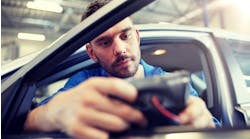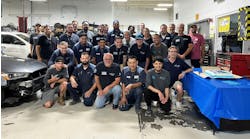Thermoset vs. thermoplastic finishes
With lacquers, the paint is a thermoplastic dried from its liquid state when sprayed to form a solid film on the vehicle. Thermoplastic paints do not chemically change when they dry and can be reflowed by adding solvents, thus returning the paint to a liquid.
Thermosets such as enamels and urethanes, though they do dry some by evaporation, primarily cure through a chemical change by the addition of oxygen (enamels) or a hardener such as the Isocyanates in urethanes. Because of this chemical change, they do not reflow or liquefy when solvents are added following the curing process.
Latex technology is neither a true thermoplastic nor thermoset but has characteristics of both. The latex, which has a core with "fingers or tendrils" surrounding it is suspended in about 85 percent water and approximately 15 percent water soluble "co-solvents," though the exact amount may vary some from one manufacturer to another.
It is this latex technology, with its tendrils, that changes the paint technology significantly from earlier paint films. It dries differently, thus reducing mottling, and provides a potentially much faster flash time. Some manufacturers' products do not require agitators for mixing bases. Because of the non-settling characteristic, mottling is potentially less. However, flow out is less, so a control coat is needed for correct metallic orientation.Non-settling technology
Some paint manufacturers that have eliminated the need to agitate mixing bases utilize pouring spouts on their tint bases. PPG recommends a gentle rocking from side to side prior to pouring. With tinting bases that do not settle, corrupt racks (mixing bases which have been poured off prior to agitating and thus produce a color mismatch), are eliminated. Latex-based paints do not need to be shaken prior to application. In fact, putting many waterborne paints on a shaker will cause excessive bubbles and should be avoided.
Waterborne paint is less prone to mottling after curing, but may look mottled before the water evaporates. As the water dries, the mottling that may be present when first sprayed will be eliminated.
Waterborne basecoats' overlap should be narrowed from a 50 percent to a 75-80 percent overlap to eliminate streaking and assure proper film coverage. A final control coat, instead of the distance of 6-8 inches as with solvent paints, is extended to 10-12 inches, with a 40 percent reduction of inlet air pressure and an 85-90 percent overlap. This will assure proper metallic orientation, so it is not needed with a solid color. The control coat may appear mottled when wet but will have a uniformly dull look when dry.
Storing and reduction
Depending on the paint manufacturer, mixing bases may be shipped to the painter with or without water added. Those paints that have water in the mixing bases are susceptible to freezing. Some companies' paints may not be as sensitive to freezing, however, most are, and when frozen they undergo a chemical change which renders them unusable. Shops should be fully aware of recommendations regarding temperature and should safeguard against storing in extreme temperatures.
Paints that come with water in them often are reduced at much lower amounts than their solvent counterparts. Their reductions may vary depending on their pigment makeup, such as 10, 20 or 30 percent, depending on the amount of pearls and other pigments in the mixture.
Flash times
With solvent-based paints, flash times can be calculated. Though affected by temperature, airflow, and humidity, they can be controlled by adjusting the temperature and reducer added. With waterborne paints, air movement is the primary driver of flash time. As waterborne paint evaporates, the air directly over the painted areas becomes saturated with humidity. Moving drier air past it will speed up the flash time. In most paint booths, air is moved in one direction, such as from the ceiling to the floor in a downdraft booth. This one-directional air, called laminar air flow, is not as effective as turbulent airflow, as produced by spray booth fans or air multipliers. Turbulent air flow devices should not be used during the spray application, but turned on to speed up flash off time before application of the next coat. Air flow influences waterborne flash time more than temperature.
Final word: Training
The best place to get product-specific training is the paint manufacturer. Once you've selected a paint line, the jobber should be your first line of information and help in setting you up. Next, you'll want training regarding the different types of waterborne paint technologies and the environmental requirements for your area. I-CAR has launched its new class, "Waterborne Products, Systems, and Application" (REF07) and an online class, "Hazardous Airborne Pollutants Reduction."
The waterborne class explores such issues as tools and equipment, application, air movement, storage and disposal. The instructor is likely to have the specific local regulations for your specific geographic area. Included in the hazardous air pollutants class is explanation of the final rule, training requirements and a list of products that fall under the new rule regulations. Studying and understanding this new technology prior to the mandated time can be critical. At the least, it will surely make the changeover less stressful.



